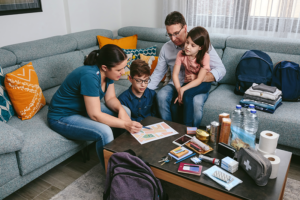Build a Disaster Supply Kit
 If the foundation of preparedness is making a plan, the centerpiece of preparedness is the disaster supply kit. A kit that includes basic essentials and is specifically compiled for you and your family’s needs will significantly ease the burdens of an emergency and its aftermath.
If the foundation of preparedness is making a plan, the centerpiece of preparedness is the disaster supply kit. A kit that includes basic essentials and is specifically compiled for you and your family’s needs will significantly ease the burdens of an emergency and its aftermath.
Building a disaster supply kit starts with an assessment of your household composition. How many members are in your home? What are their ages? Unique needs? And do you have pets? These are all some preliminary questions to ask yourself to begin identifying supplies you will need in the event of an emergency.
A complete kit includes more than food, flashlights and batteries; it should also include medicine and clothes, eating utensils, age-appropriate games, and tools for emergency repairs—anything critical to daily living for an entire household for a minimum of three days, and an optimum of two weeks.
Below is a list of standard items to include in a disaster supply kit. Based on your household makeup and needs, you may find there are other critical items to include. Sit down with all household members to review your disaster supply kit list – this will ensure individual needs are considered.
What to include – check out the following list of basic disaster supply kit supplies:
- Water – one gallon per person per day for at least three days. This is a minimum; more is often needed.
- Food – a three-day supply of non-perishables such as tuna and peanut butter. Don’t forget to pack a manual can opener!
- Pet food – a three-day supply (if applicable)
- Eating utensils
- Battery-powered, hand crank radio, or a battery-powered NOAA Weather Radio that sends alerts
- Flashlights, camping lamp, or battery powered candles
- Batteries for radio and flashlights/lamps
- Cell phone chargers and cell phone battery back up
- First aid kit (e.g., band aids, thermometer, gauze and wound disinfectant)
- Face masks (for COVID-19 and to filter debris in the air as needed)
- Personal hygiene items – toothbrush, toothpaste, soap, shampoo, feminine hygiene supplies
- Prescription and non-prescription medicines such as pain relievers
- Medical equipment – walkers, hearing aids, etc. (if applicable)
- Eyeglasses (if applicable)
- Moist towelettes or hand sanitizer
- Important legal documents – insurance policies, banking information, passports, driver license or other identification (this helps expedite disaster assistance if available). Place in waterproof or plastic container
- COVID-19 supplies – disposable masks, disinfectant wipes, thermometer
- Contacts – paper list – contacts in other states, emergency numbers, friends, family and doctors
- Whistle and white towel to signal for help
- Garbage bags and plastic ties for assorted uses
- Wrench and pliers to turn off utilities and other handheld tools for minor emergency repairs
- Local maps for evacuations and other location use
Additional/elective items to consider
- Blankets, pillows
- Change of clothes, heavy shoes, rain gear, coat
- Heavy gloves for handling debris
- Fire extinguisher
- Mess kit or paper plates, cups, plastic forks, spoons and knives
- Books and other reading materials
- Photos – keep in plastic container (not an emergency item but often unreplaceable)
- If you have a pet(s), make sure to have a photo of you and your pet together in the event you need to show proof of ownership if separated.
- Photos of your children in case they get lost or you get separated.
- Age-appropriate games – puzzles, coloring books, deck of playing cards, etc.
- Stuffed toy for the very young
- Pen, paper or notebook
- Battery-powered camp fan
- Battery-powered television
Foods for thought
- Dried fruits
- Snack foods (individual serving bags) for everyone, especially children, to ease boredom
- Canned nuts
- Power or protein bars
- Unopened, individual servings of boxed, shelf-life milk
- Non-perishable shelf pudding or gelatin desserts in cups
And last, but not least additions …
Some of these items are best suited for a noticed emergency, such as a hurricane.
- Cash – ATMs may not work for days
- Ice and cooler- best for sheltering in place. Ice usually not supplied by disaster response
- Car kit – a small cache of emergency supplies, including water, a white towel to signal for help and a first aid kit for the glove box.
- Workplace kit – include non-perishable food and personal hygiene items for 24 hours of sheltering in place.
COVID-19 precautions
Have plenty of disposable masks in an emergency kit and disinfectant wipes. For COVID-specific information about precautions, check with the Centers for Disease Control, here.
Plan today for tomorrow. Emergencies and disasters can occur at a moment’s notice, and you can get ahead of them by making a plan. It can be days before disaster assistance arrives, especially following hurricanes and earthquakes. Those disasters can upend life for weeks. A three-day emergency kit will help, but 14 days of supplies would be a better option for self-reliance or resilience in extreme situations.
An disaster supply kit should be kept in an accessible storage area. Supplies should be inventoried, replenished or updated two or three times a year or as household composition or needs change.
It takes a village – following a disaster, communities will rebuild quicker if neighbors’ band together. Following a disaster, check on senior neighbors and disabled persons nearby when all is clear. Some may not have emergency supplies on hand or be able to afford keeping a kit on hand—another reason to plan well.




